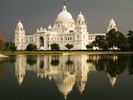India's Brahamputura River is one of the longest rivers in the world at 2,948 km long, and has a discharge of 19,200 cubic litres per second, being the only river on earth clearly visible from the moon during the Apollo missions. The river originates on the Angsi Glacier located on the northern side of the Himalayas in Burang County of Tibet. The source of the river was earlier thought to be on the Chemayungdung glacier, which covers the slopes of the Himalayas about 97 km (60 mi) southeast of Lake Manasarovar in south-western Tibet. The river in places can be up to 20 miles wide and in the monsoon, it floods the entire Assam plain. Flowing down from central Tibet through the legendry Tsang-po gorges, the Brahmaputra river opens out as it enters Assam to flow across that state and then through Bangladesh to flow out through the vast Sunderbun Delta, merging with the Ganges River, as they discharge into the Bay of Bengal.










